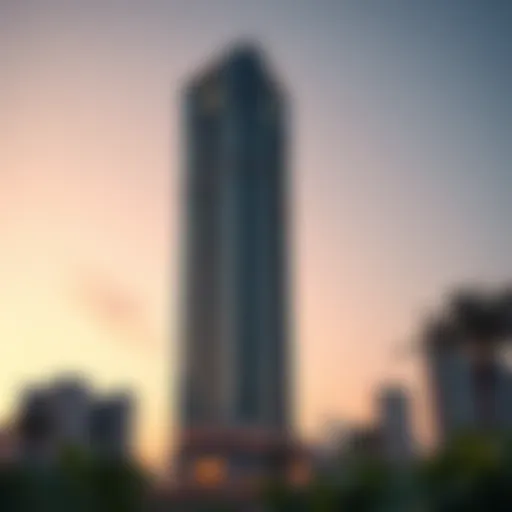Exploring Tower Building in Dubai's Real Estate Market
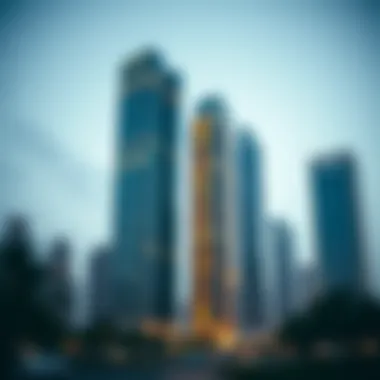

Intro
As the sun sets over the ever-evolving skyline of Dubai, the silhouettes of towering structures rise majestically against the horizon. The landscape is not just a testament to architectural ingenuity but also reflects a bustling real estate market that has captured the eye of both local and international investors. Tower building in Dubai is a complex dance of ambition, regulation, and innovation. It captivates not only the residents who call this vibrant city home, but also the investors keen on reaping benefits amidst the shifting sands of the market.
Understanding the intricacies of tower development in Dubai is crucial for anyone looking to navigate this unique real estate terrain. This article will detail the pivotal components that shape the city’s impressive skyscrapers, from market trends and investment strategies to sustainability considerations that future-proof these colossal structures for generations to come.
Understanding Tower Building
Tower building is not just a quest for height; it's about crafting skylines that morph into symbols of economic progress and urban identity. In the ever-evolving context of Dubai's real estate landscape, understanding the nuances of tower construction becomes pivotal. These skyscrapers represent not only architectural prowess but also the cultural and social aspirations of a burgeoning metropolis. The importance of this inquiry is compounded by the fact that the city is home to some of the tallest and most iconic structures in the world. Each tower has its own tale, encapsulating the ambition of its creators and the vision of its investors. Ultimately, recognizing the significance of tower building offers stakeholders a clearer lens through which to assess the market's trajectory.
Definition and Significance
Tower building refers to the construction of high-rise structures that often serve multiple purposes, including residential, commercial, and mixed uses. The significance of these tall edifices extends beyond mere height; they lead to efficient land use, especially in densely populated areas, allowing for a concentration of resources and accessibility. Investments in tower projects are usually substantial and come with their set of risks and rewards, making a comprehensive understanding vital for investors and homebuyers alike.
Historical Context of Skyscrapers
The narrative of skyscrapers is rich and complex, woven into the very fabric of urban development across the globe. Not merely structures of concrete and steel, they symbolize aspiration and economic vitality.
Global Examples
Globally, cities such as New York and Shanghai have paved the way for the skyscraper revolution. The Empire State Building and the Shanghai Tower stand tall, representing not just architectural achievements but also the pursuit of economic growth. These buildings are not only aesthetic marvels but also functional solutions to urban challenges. A key characteristic of these global examples is their mixed-use nature, often housing offices, residences, and leisure spaces all under one roof. This multi-functionality caters to the contemporary lifestyle, making them a popular choice for investors seeking diverse revenue streams. A unique feature that stands out in these structures is their use of advanced engineering techniques that allow for increased height without compromising safety. However, the challenges that arise from such ambitious projects can not be overlooked, from environmental concerns to high construction costs.
Evolution in Design
The evolution in skyscraper design has been noteworthy, shifting from simple glass and steel boxes to intricate forms that blend functionality with artistry. Over the years, architectural firms have experimented with various styles, showcasing innovation in both aesthetics and technology. This is beneficial since it pushes the boundaries of what high rises can accomplish. A significant aspect of this evolution is the integration of sustainable building practices, placing greater emphasis on energy efficiency and resource conservation. Among its unique features, the incorporation of green roofs and advanced insulation systems not only enhances the building's ecological footprint but often leads to reduced operational costs as well. On the downside, such ambitious designs can inflate the overall budget and prolong construction timelines.
"Skyscrapers reflect the soul of a city, whispering tales of dreams and aspirations with every floor they rise."
In understanding these dual elements of historical context and design evolution, stakeholders can glean insights about the current landscape of Dubai’s towers. It’s this intricate weaving of history and innovation that defines the enduring appeal of tower building in one of the world’s most dynamic real estate markets.
Dubai’s Architectural Landscape
The architectural landscape of Dubai is much more than a mere collection of towers; it represents a bold vision of urban sophistication that draws people from all corners of the globe. The context in which these structures exist is vital, as they not only redefine the city's skyline but also embody the aspirations of the region. Each tower has a specific role in the narrative of Dubai's growth, offering unique insights into the blend of culture, innovation, and investment that shapes the real estate market.
Overview of Current Towers
At this junction, one must recognize the impressive array of towers that paint the Dubai skyline. These buildings aren't just vertical spaces; they are hubs of commerce, living, and leisure. The current towers can range from luxurious residential spaces, such as One Za'abeel, to commercial giants like the Emirates Towers. Developing clear listings and detailed analyses enable investors and buyers to gauge their suitability in light of market trends.
Some key towers to note include:
- One Za'abeel: Once completed, this building is expected to house one of the world's highest occupied floors.
- The Address Downtown: Known for its targeted marketing towards high-end tourists, this tower is close to key attractions.
- Jumeirah Beach Residence: Catering primarily to expatriates, it combines seaside living with urban convenience.
This developing landscape not only offers diverse living choices but also paves the way for future innovative projects.
Iconic Towers and Their Impact
Burj Khalifa
The Burj Khalifa, towering at over 828 meters, stands as both a feat of engineering and a cultural icon. It's not just the world's tallest building, but it also serves as a symbol of Dubai's ambitious spirit. The sky deck offers panoramic views that attract tourists, and the luxury apartments provide property investment opportunities.
One compelling feature of the Burj Khalifa is its unique design, inspired by Islamic architecture, which makes it a beneficial representation for the emirate. However, some might argue that while it draws visitors by the droves, the high cost of property there may limit investments for the average homebuyer.
Burj Al Arab
Known as the world's only seven-star hotel, the Burj Al Arab epitomizes luxury in Dubai. Its sail-like shape captures the essence of modern maritime architecture. This iconic structure not only attracts tourists but also enhances real estate values in its vicinity. Featuring lavish suites and fine dining, it’s a prime example of how luxury can drive market interest.
A unique aspect of the Burj Al Arab is its artificial island, which accentuates its exclusivity. While the hotel establishes a solid reputation, the property's availability for investment is limited, catering mostly to high-net-worth individuals seeking unparalleled luxury.
Dubai Marina Towers
The Dubai Marina Towers are a remarkable mix of residential, commercial, and leisure spaces. Located within one of the most desirable waterfront neighborhoods, this cluster plays a significant role in the push for high-rise living in Dubai. The towers offer stunning views of the marina and easy access to cafes and shops, leading to a vibrant lifestyle.
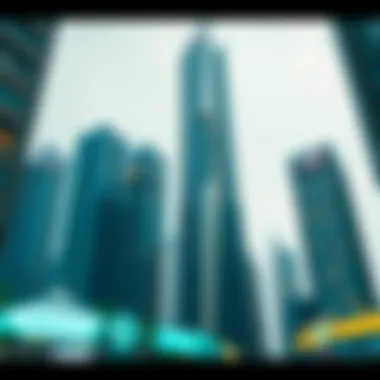
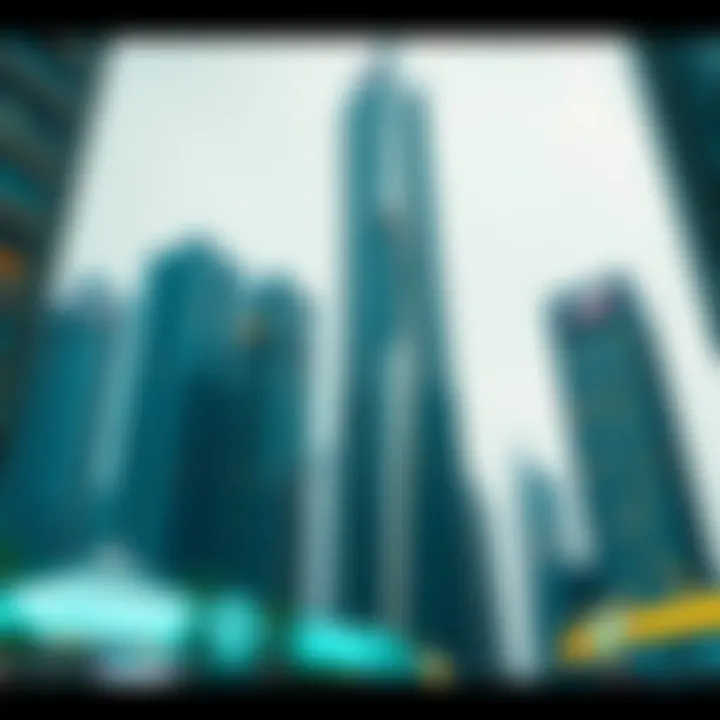
The key characteristic of the Dubai Marina Towers is their focus on community engagement, creating a live-work-play environment that resonates with both residents and outsiders. While apartments may be on the pricier side, the amenities and location justify the investment, making them attractive for potential homebuyers and investors alike.
The architectural grandeur of Dubai is not just in its design but in how these towers enhance the lifestyle and economy of the region.
The Economics of Tower Development
The economics of tower development plays a crucial role in shaping the skyline and the real estate landscape of Dubai. Understanding the economics behind skyscraper construction can reveal patterns and insights that significantly impact investors and other stakeholders in the market. As Dubai continues to attract both local and international investment, recognizing the economic factors driving tower development becomes increasingly essential.
The costs associated with designing, constructing, and maintaining skyscrapers often require substantial financial backing. This can lead to innovations in funding approaches and structures that align with the evolving interests of investors and developers.
Investment Trends in Skyscrapers
Market Demand
Market demand for tower developments in Dubai has been consistently fueled by rapid urbanization, population growth, and a thriving tourism sector. A key characteristic of this demand is the influx of expats and foreign investors seeking favorable living and business conditions. This translates to a high interest in residential, commercial, and mixed-use properties.
The sheer scale of demand is revealing; Dubai is often seen as a hub for foreign investments, thus driving developers to keep pace with the evolving expectations. It’s beneficial as investment trends shift toward futuristic designs and sustainable construction practices, ensuring new projects resonate with the lifestyle aspirations of a diverse clientele. However, the unique feature of this demand is its volatility, which can be attributed to global economic fluctuations.
This brings about both advantages, such as high profitability potential for successful projects, and disadvantages, like over-saturation in the market leading to potential financial losses for miscalculated developments.
Pricing Trends
Pricing trends are highly influential in the overall economics of tower development. The cost of real estate in Dubai varies largely based on the location, amenities, and overall market conditions. A noteworthy characteristic is the constant fluctuation of prices influenced by factors such as economic stability, demand patterns, and regulatory changes. Investors typically perceive these fluctuations as a double-edged sword: high demand can lead to skyrocketing prices, while economic downturns can generate significant price drops, affecting ROI.
In terms of unique features, luxury properties often command premium prices due to their exclusive amenities and prime locations, while mid-range developments may attract a broader market. The advantages of understanding pricing trends include informed investment decisions, allowing stakeholders to strategize accordingly; however, the downside may involve the risks of investing during a market downturn or price slump.
Funding and Financing Structures
Public-Private Partnerships
Public-private partnerships (PPPs) have emerged as a significant funding mechanism in Dubai's tower development scene. These arrangements harness the strengths of both the public sector, which can provide infrastructure and regulatory support, and the private sector, which brings in innovation and capital investment. The key characteristic here is the collaborative approach to development, which often leads to more sustainable and impactful projects.
This form of financing is beneficial as it allows for large-scale projects that might not be feasible through traditional funding alone. One unique feature of PPPs is the risk-sharing structure; both parties contribute resources and share in the rewards and consequences of the developments. This cooperation can lead to enhanced public trust but may also lead to complications if expectations are not clearly defined, potentially delaying projects.
Foreign Investment
Foreign investment in Dubai's tower projects remains a pivotal aspect of the real estate landscape. High-net-worth individuals, institutional investors, and sovereign wealth funds are positioning themselves to capitalize on the rising demand for luxury living and business environments. The key characteristic of foreign investment is its ability to provide significant capital influx, driving faster and more expansive developments.
This form of investment is particularly beneficial as it increases market liquidity and creates a diverse property portfolio. A unique feature is the ability for foreign investors to often leverage their capital in ways that enhance project viability. However, challenges may arise due to changing regulations regarding foreign ownership and investment, potentially impacting market confidence.
Overall, the economic aspects of tower development in Dubai provide a multifaceted view of the forces shaping the real estate landscape. Contextualizing these principles helps investors, developers, and stakeholders make informed decisions in navigating this dynamic market.
Regulatory Framework
The regulatory framework surrounding tower building in Dubai is a pivotal aspect shaping the real estate landscape. As the structures reach new heights, both literally and figuratively, it is imperative for investors, developers, and homeowners to understand the regulations that govern construction. These rules ensure that each project aligns with safety, sustainability, and urban planning goals, impacting not only the immediate vicinity but the broader community as well.
Building Codes and Regulations
Safety Standards
Safety standards represent a cornerstone of the regulatory framework in Dubai’s skyscraper development. These standards are designed to protect the well-being of residents, workers, and visitors alike. One standout characteristic of these safety protocols is their rigorous requirement for materials and construction practices, which must withstand the challenging climate and seismic activity. In essence, these standards help in mitigating risks associated with extreme weather and potential construction hazards.
A key feature of the safety standards is their adaptability. With advancements in technology and engineering, these standards are regularly updated. This ensures that builders adopt the latest techniques and materials that enhance both safety and durability. While these measures can increase construction costs initially, they ultimately offer significant long-term benefits by reducing maintenance needs and potential liabilities. For instance, the use of fire-resistant materials not only complies with safety standards but also provides peace of mind to owners and residents, knowing their homes are safer.
"In Dubai, safety isn’t just a box to check off; it's the very foundation upon which towering dreams are built."
Zoning Laws
Zoning laws play a crucial role in regulating land use and determining where towers can be constructed. A notable characteristic of Dubai's zoning policies is their focus on promoting mixed-use developments, which integrate residential, commercial, and recreational spaces. This approach encourages vibrant communities and efficient land use, contributing to the overall urban environment.
A unique feature of these zoning laws is their flexibility. Authorities often engage in discussions with developers to accommodate projects that meet both community needs and regulatory requirements. While this flexibility can facilitate innovative designs and land use, it can also lead to a lack of consistency in development. Investors may need to navigate a maze of approvals and community consultations, which, while beneficial for community engagement, can also delay project timelines and increase costs.
Government Policies Impacting Development
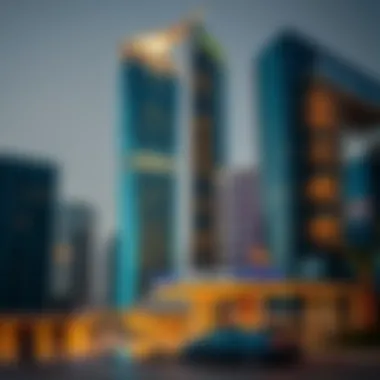
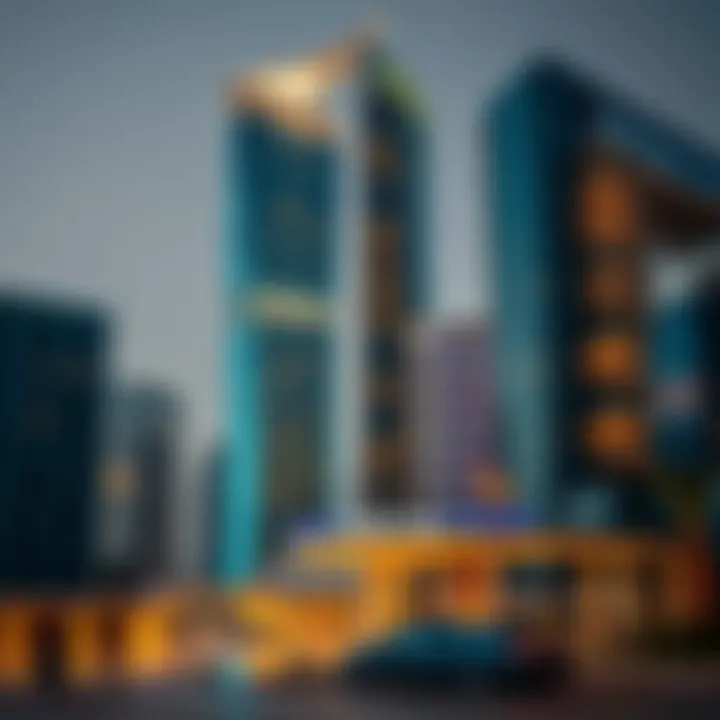
Government policies significantly impact the direction and pace of tower development in Dubai. The Emirate actively promotes its real estate sector as a driver of economic growth, implementing policies that encourage foreign investment and support innovative building practices. One of the landmark initiatives is the Dubai Vision 2021, which strives to make the city a global model for sustainability and livability. Such policies not only attract foreign capital but also ensure that development aligns with broader social and environmental goals.
Moreover, government-backed incentives often lower the entry barriers for new projects, enabling a diverse range of towers to dot the skyline. However, these policies are continuously evolving, influenced by economic conditions and global trends. Stakeholders in the real estate market need to remain vigilant, adapting to changes that may affect project feasibility and investment returns.
In summary, understanding the regulatory framework, encompassing safety standards and zoning laws, is essential for navigating Dubai's landscape of towering ambitions. As investors and developers engage with these regulations, they can better align their projects with the city’s vision and, ultimately, contribute to the ever-changing skyline.
Sustainable Practices in Tower Construction
In the context of tall structures, sustainable practices are increasingly critical in shaping the future of tower building in Dubai's real estate landscape. These practices not only serve to minimize the environmental footprint of skyscrapers but also play a pivotal role in enhancing the overall livability of urban spaces. With the global focus on climate change and resource conservation, incorporating sustainability into tower design is no longer just a trend; it’s becoming a necessity.
Green Building Certifications
Green building certifications, such as LEED (Leadership in Energy and Environmental Design) and BREEAM (Building Research Establishment Environmental Assessment Method), are essential benchmarks for sustainable construction. These certifications ensure that buildings meet rigorous environmental standards throughout their lifecycle—from design and construction to operation and maintenance.
- Benefits of Certification:
- Enhanced Energy Efficiency: Buildings that achieve such certifications typically consume less energy, translating into lower operational costs.
- Market Appeal: For buyers and renters alike, certified buildings offer an assurance of quality and sustainability, often commanding higher prices.
- Resource Optimization: These standards encourage the use of local materials and sustainable resources, reducing waste.
Green certifications help not only in gaining recognition but also in building trust with investors and occupants, laying down a pathway to a more sustainable urban environment.
Innovative Technologies in Tower Design
Energy Efficiency
When discussing energy efficiency, we focus on how these systems play a vital role in reducing energy consumption in skyscrapers. Energy-efficient designs include elements like advanced insulation, smart windows, and HVAC systems that adjust based on occupancy levels.
- Key Characteristic: One of the main characteristics of energy efficiency in tower construction is the use of renewable energy sources, such as solar panels or wind turbines.
- Why It’s Popular: This approach is attractive within the Dubai real estate market due to the region's abundant sunlight and wind resources.
- Unique Feature: An energy-efficient building often features automated systems that manage energy use based on real-time data.
The advantages of energy-efficient designs are clear: they reduce operating costs and environmental impact while ensuring that buildings remain competitive in an ever-evolving market. However, the initial investment can be a challenge for developers, as high-efficacy materials and systems might raise construction costs temporarily.
Smart Buildings
Smart buildings are revolutionizing how we perceive and interact with our living spaces. These structures utilize integrated technology to enhance the efficiency and comfort of their occupants.
- Key Characteristic: One prominent trait of smart buildings is their ability to monitor indoor environments, adjusting lighting, temperature, and air quality for optimal comfort.
- Why They’re Valued: This adaptive capacity is a big draw for both residents and businesses looking to optimize productivity and comfort levels.
- Unique Feature: Smart buildings often come equipped with systems that provide data analytics, allowing management teams to foresee maintenance needs or energy consumption patterns.
The advantages of smart buildings extend to increased safety and convenience, but the reliance on technology also poses challenges such as cybersecurity threats and the need for continuous updates to software systems. Nevertheless, integrating smart technology into tower construction aligns perfectly with the overarching goal of creating sustainable urban landscapes, thereby creating long-lasting value for investors and occupants alike.
"Sustainability is not just a goal, it’s a way to secure the future of our cities."
In summary, implementing sustainable practices in tower construction, through green certifications and innovative technologies, leads to a more environmentally friendly, cost-effective, and adaptive approach to urban living in Dubai. This evolution underscores the importance of sustainability as a cornerstone of modern architecture, influencing everything from planning to long-term profitability.
Social and Cultural Implications
Understanding the social and cultural implications of tower building in Dubai goes beyond aesthetics or structural integrity. These monumental structures reshape communities and reflect the evolving identity of the city. As towers rise, they create not just skyline vistas but also the fabric of urban life, contributing to a mix of cultures, lifestyles, and social interactions. The implications can be profound, affecting how individuals and families experience their environment and how businesses connect to these growing communities.
Impact on Community and Lifestyle
The impact on community and lifestyle from towering edifices is significant. High-rises often serve as hubs of activity; they house shops, restaurants, offices, and residences under one roof. This convenience speaks volumes in a bustling metropolis like Dubai. With close proximity to workplaces, schools, and leisure spaces, such developments can minimize commuting time, granting families a healthier work-life balance.
For instance, the Dubai Marina area showcases how tower developments influence community dynamics. Residents enjoy not only luxurious views of the waterfront but also community events and social hubs that foster interaction among diverse nationalities. When people from various cultural backgrounds come together in public spaces, it nurtures a vibrant sense of cosmopolitan life.
Moreover, the blending of cultures enhances mutual understanding and acceptance. Towers provide a platform for cultural exchange through art installations, community events, and outdoor markets. Such activities encourage residents to engage with one another, forging a stronger sense of belonging.
Public Spaces vs. Private Developments
The distinction between public spaces and private developments within tower construction plays a crucial role in urban planning. Public spaces are essential for creating inclusive environments. They should not be overlooked in favor of the commercial potential of private developments. Successful tower projects balance the two, ensuring that while stakeholders achieve financial profitability, the community's needs are also met.
Private developments may cater to exclusive markets, which can sometimes exclude lower-income residents. When towers cater solely to the upper echelon, it risks creating enclaves perceived as detached from the rest of the city.
Conversely, public spaces — parks, plazas, or art installations within or adjacent to high-rise buildings — can significantly enhance the urban experience. They invite leisure, provide relaxation spots, and foster community interactions. For instance, the Creek Tower project aims to incorporate a large public park area that welcomes visitors from all walks of life. This highlights the effort to unite the development with the surrounding environment, enhancing the overall appeal of the space.
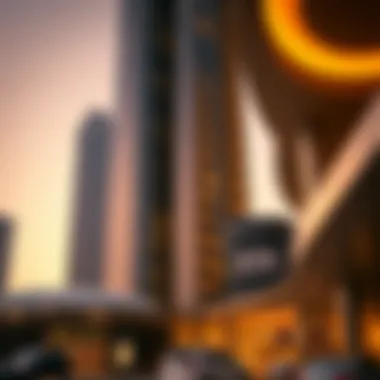
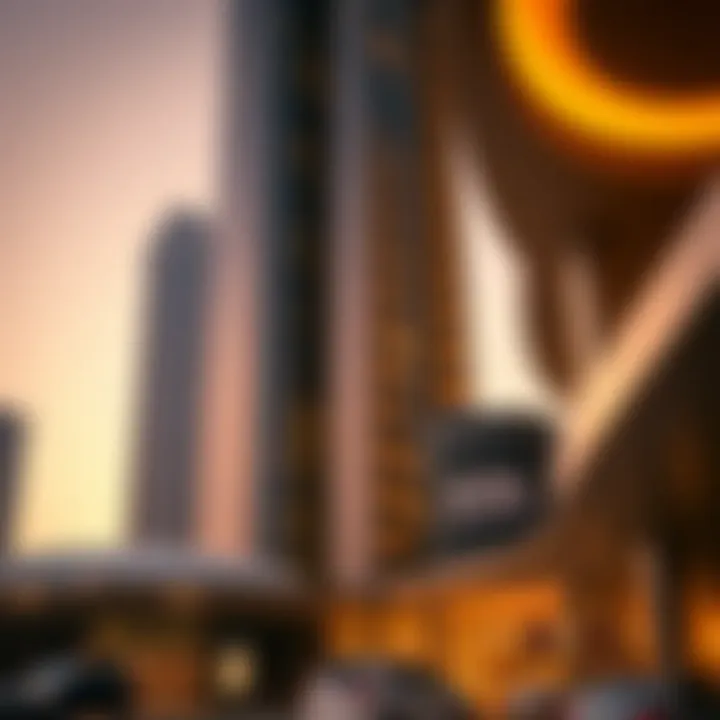
"The most beautiful thing about architecture is that you can create a community out of thin air."
For further exploration of community-building through urban architecture, check out resources at Wikipedia or Britannica for in-depth insights.
Case Studies of Major Projects
Case studies of major tower projects in Dubai offer an in-depth look into the practical applications of architectural vision, engineering prowess, and market dynamics. Each project represents a unique combination of ambition and pragmatism, shedding light on how Dubai's rapidly evolving skyline serves as a mirror for its economic aspirations. These studies not only highlight the successful outcomes but also the challenges encountered.
Understanding these complexities is crucial for homebuyers, investors, and analysts; it sheds light on risk assessment and investment viability in a competitive market. By dissecting individual projects, stakeholders can grasp the broader trends that influence the real estate market in Dubai, aiding them in making informed decisions about future investments.
Exploring Recent Developments
Recent developments in Dubai’s tower landscape exemplify the city’s commitment to innovation and sustainability. Several notable projects have emerged, each pushing the envelope of design and eco-friendliness. For instance, the Dubai Creek Tower, projected to outdo the Burj Khalifa in height, not only symbolizes an architectural achievement but also utilizes cutting-edge technologies aimed at energy efficiency. This aligns well with global green standards, which is becoming increasingly important for investors.
Furthermore, the One Za'abeel, home to the world’s highest occupied building, showcases how luxury can coalesce with functional modern living. It incorporates smart technology within its design, appealing to a tech-savvy clientele looking for residential space with a dash of opulence.
Lessons Learned from Iconic Structures
Challenges Faced
Every towering structure comes with its set of challenges. Issues such as site constraints, budget overruns, and regulatory hurdles often stall even the most ambitious projects. For example, during the construction of the Burj Khalifa, developers faced significant delays due to unexpected geological conditions. These challenges prompt developers to rethink their approaches and innovate solutions that might pave the way for future endeavors.
A critical characteristic of these challenges is their capacity for learning; each difficulty encountered can lead to improved methodologies and future readiness. This contribution is vital for stakeholders aiming to replicate or mitigate such impediments in their future projects.
Successful Outcomes
On the flip side, successful outcomes offer invaluable insights into what can be achieved through careful planning and execution. The remarkable completion of the Burj Khalifa not only cemented Dubai’s position on the world stage but also demonstrated the potential for attracting tourism and investment like never before.
The unique feature of this project's success lies in its ability to merge aesthetic flair with functional implications. It created a ripple effect in the surrounding property markets, benefiting local businesses and increasing land value markedly. Such outcomes are highlighted as models for investors looking to understand how landmark properties can yield both direct and indirect return on investment.
Understanding the interplay between challenges and successes in tower construction enables stakeholders to navigate Dubai's real estate complexities more effectively. Potential pitfalls transform into stepping stones toward innovative solutions.
By examining these case studies, a clearer picture emerges, one that serves as a blueprint—not only for current market players but for those eyeing future ventures in Dubai's ever-expanding skyline.
Future of Tower Building in Dubai
The future of tower building in Dubai holds immense significance as the city continues to evolve into a prime global destination for investment, tourism, and business. The skyline that graces Dubai is not merely a collection of impressive structures; it embodies ambitions, innovations, and the relentless spirit of progress. Examining this topic allows for an understanding of how various elements interact to shape the future landscape.
With the expansion of the real estate market driven by both local and foreign investments, understanding the trajectory of tower construction becomes crucial for stakeholders. The implications of this evolution extend beyond architectural aesthetics; it bears upon economic viability, sustainability, and urban planning considerations that influence daily life within the community.
Emerging Trends and Innovations
The tower building sector in Dubai is seeing a slew of emerging trends and innovations that reflect global shifts as well as local priorities.
- Smart Technology Integration: Modern skyscrapers are increasingly incorporating smart technologies to improve efficiencies. From energy management systems to advanced security mechanisms, these features not only enhance the tenant experience but also reduce operational costs.
- Sustainability: Green building initiatives are no longer an option; they have become a requirement. Innovations aimed at energy efficiency, including solar panels and smart glass, are setting the tone for future designs. The new regulations demand developers go beyond just complying; they must innovate.
- Modular Construction: Prefabrication techniques are gaining traction. Structures are being built in sections off-site and then assembled on location. This minimizes waste and shortens construction time without compromising quality.
- Mixed-Use Developments: Increasingly, developers are opting for designs that combine residential, commercial, and leisure spaces within a single structure. This approach fosters a sense of community, encourages pedestrian traffic, and enhances the locale’s vibrancy.
- Cultural Resonance: Beyond practicality, there's a growing emphasis on cultural significance. Designers are finding ways to reflect local heritage in modern architectures, creating a bond between the past and the present.
"The skyline is not just steel and glass; it tells the story of a city’s evolution and dreams."
Long-Term Market Predictions
When projecting the long-term market predictions for tower building in Dubai, several considerations come into play.
- Population Growth: As Dubai experiences continued population growth, the demand for residential and commercial real estate is expected to rise. This provides a fertile ground for the construction of new towers and revitalization of existing ones.
- Economic Factors: Global economic fluctuations may impact investment trends. Nonetheless, the strong economic indicators for Dubai, such as tourism and trade, suggest resilience and promise in the property market.
- Legislative Changes: Shifts in government policies—like easing foreign ownership laws—can attract international investors, demonstrating a potential uptick in major tower projects.
- Technological Adaptations: As construction technologies advance, the cost of building cutting-edge towers is likely to decrease, paving the way for more structures that incorporate innovations without breaking the bank.
Closure
The realm of tower building in Dubai's real estate landscape is a multifaceted domain, intricately woven with architectural innovation and economic strategy. This article has unpacked various elements that contribute to the skyline which defines Dubai today. Understanding these insights is crucial for all stakeholders involved—be it homebuyers, investors, agents, analysts, or expats. The factors discussed go beyond mere trends; they offer a window into the potential that lies ahead.
Summary of Key Insights
The journey through the architectural brilliance of Dubai revealed several key takeaways:
- Architectural Mastery: The skyscrapers of Dubai represent a blend of art and engineering prowess, pushing the boundaries of design while maintaining functionality.
- Economic Considerations: Investment trends indicate a robust appetite for skyscraper development, driven by local and foreign investors keen on both commercial and residential opportunities.
- Regulatory Framework: Understanding the local regulations, including safety standards and zoning laws, is imperative for navigating the landscape of tower construction successfully.
- Sustainability Practices: Increasing emphasis on green building certifications and smart technologies exemplifies a shift towards sustainable development in this arena.
- Cultural Impact: The interplay between public spaces and private developments underscores the importance of community and lifestyle in shaping the identity of Dubai’s rapidly growing urban environment.
Final Thoughts on Investment Opportunities
As we look at the horizon of Dubai's towering ambitions, significant investment opportunities abound. Here are some considerations:
- Long-Term Growth Potential: With the global demand for urban living spaces continuously on the rise, investing in Dubai's towers offers the prospect of stable returns.
- Location Matters: When scouting for investment, the location of the tower plays a vital role. Proximity to transport links, business districts, and recreational areas can significantly affect value.
- Market Dynamics: Staying informed about the evolving market dynamics will provide investors an edge. Trends in housing demands and economic factors contribute to this complexity.







